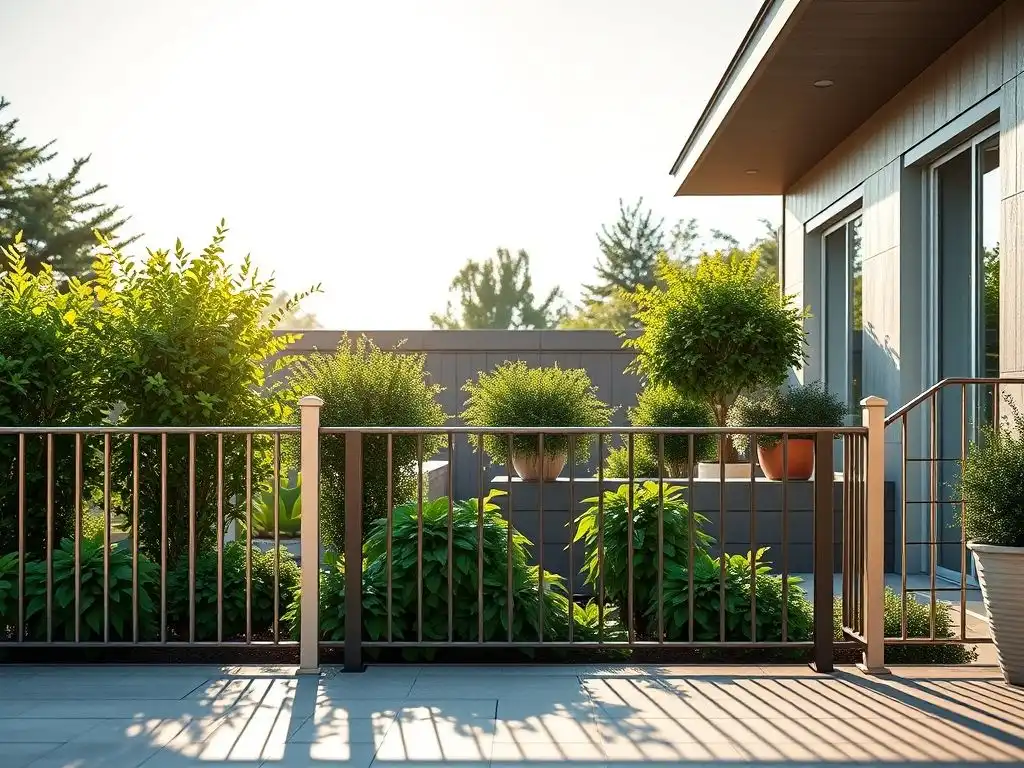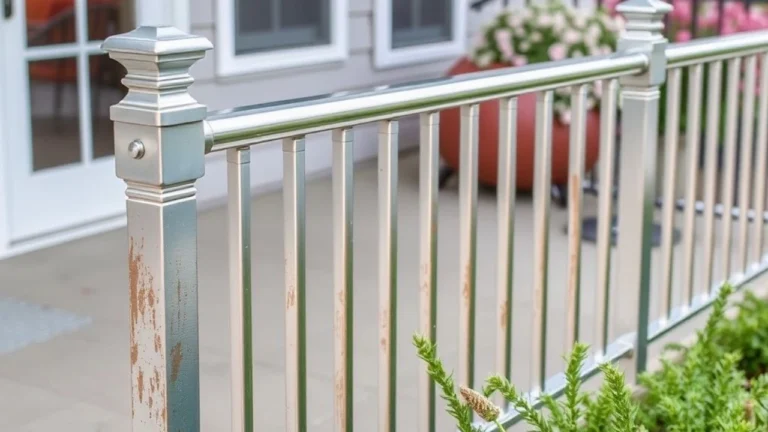Types and Properties of Aluminum Railings: Your Complete Reference Guide

Aluminum railings are popular in modern home design. They are versatile, durable, and attractive. This guide will explore the different types and features of aluminum railings. By the end, you will know how to choose the right railing system for your needs.
Related products – Aluminum Deck Railing
Common Types of Aluminum Railings
Picket Railings
Aluminum picket railings have vertical balusters between the top and bottom rails. They look classic and are strong. These railings are easy to maintain and suitable for homes and businesses.
Glass Railings
Aluminum-framed glass railings are strong and elegant. They come in a few styles:
- Fully framed: Aluminum around all glass panels.
- Semi-frameless: Few vertical supports.
- Frameless: Full visibility without obstructions.
Cable Railings
These railings use horizontal cables between aluminum posts. They give a modern look and keep the view clear.
Related products: Aluminum cable railings
Drink Rail Systems
This design features a wider top rail, perfect for placing drinks. It adds functionality and style to outdoor spaces.
The Main Features
Aluminum railings are a great choice for modern construction projects due to their exceptional performance and practical benefits.
Core Performance Features
Aluminum railings are durable and strong. They can handle harsh weather, from intense sunshine to heavy rain and snow. Despite being lightweight, they offer strong support. The natural oxide layer on aluminum prevents rust, creating a long-lasting self-protecting barrier.
Temperature Performance
Aluminum easily adapts to temperature changes. It stays stable without warping or stressing, keeping its look and function across seasons.
Easy Maintenance Benefits
Aluminum railings are low-maintenance:
- Clean with soap and water
- No need for painting or refinishing
- Resist rot and decay
- Safe from insect damage
Design Possibilities
The versatility of aluminum railings provides many design options.
Color and Finish Selection
| Feature | Advantage |
|---|---|
| Powder coating | Long-lasting color protection |
| Multiple finishes | Matches any architectural style |
| Custom colors | Perfect coordination with buildings |
Design Elements
Aluminum railings cater to various design preferences with options like:
- Glass panel inserts for a modern look
- Traditional picket styles
- Decorative patterns
- Mixed material combinations
The powder coating adds protection and ensures consistent color. This coating is resistant to chipping, fading, and peeling, maintaining the railings’ appearance over time.
Each design element is attractive and functional. The variety of patterns and styles ensures that these railings complement any architecture while remaining durable.
Aluminum vs. Stainless Steel Railings
When choosing between aluminum and stainless steel railings, consider strength, durability, and cost. Here’s a breakdown of these materials to help you decide.
Strength
Stainless steel is very strong, making it great for high-traffic commercial spaces. Aluminum, though lighter, offers a high strength-to-weight ratio, making it easy to install.
Durability
Stainless steel excels in tough environments. It’s ideal for beachfront properties as it resists salty sea spray. Aluminum also has built-in corrosion resistance, acting like a shield that doesn’t need replacing.
Cost
Aluminum is more budget-friendly, providing great value upfront. Stainless steel costs more initially but offers high quality. Both materials require minimal maintenance over time, making them cost-effective in the long run.
Here’s a quick comparison table:
| Feature | Aluminum | Stainless Steel |
|---|---|---|
| Initial Cost | Lower | Higher |
| Weight | Lightweight | Heavier |
| Strength | Good | Excellent |
| Corrosion Resistance | Natural | Superior |
| Maintenance Needs | Minimal | Minimal |
Both materials work well in residential and commercial settings. Choose the one that best meets your needs.
Read more: Steel vs aluminum railings
Composite vs Aluminum Deck Railings
Appearance and Design
Composite railings replicate the natural beauty of wood, creating a traditional outdoor atmosphere. Aluminum railings showcase modern, clean lines that enhance contemporary homes. Both materials offer multiple color choices and design patterns to match your home’s exterior.
Cost Analysis
A simple cost breakdown reveals:
- Composite railing systems: $40-60 per linear foot
- Aluminum railing systems: $70-100 per linear foot
Aluminum Railing Benefits
Aluminum stands out with practical advantages:
- Weighs less than composite materials
- Simple and quick installation process
- Creates an open, airy appearance
- Resists rain, snow, and sun damage effectively
Composite Railing Strengths
Composite materials excel in several areas:
- Creates a warm, natural wood appearance
- Offers better initial price value
- Blends seamlessly with composite decking
- Provides extensive color selection options
Making Your Choice
Consider these key factors:
- Budget requirements
- Preferred maintenance level
- Local weather conditions
- Home architectural style
The right choice depends on your specific needs. Aluminum works best for homeowners who want low maintenance and modern style. Composite suits those who prefer traditional aesthetics and lower upfront costs.
This straightforward comparison helps you select the railing material that matches your home’s style, budget, and maintenance preferences. Each option brings distinct benefits to your outdoor space.
Types of Glass Railings for Aluminum Frames
Glass railings combine with aluminum frames to create safe, attractive barriers. Here are the main types available:
Framed Glass Systems
Aluminum frames completely surround the glass panels in these systems. The full framework provides maximum support and stability. These systems excel in high-traffic locations where safety is paramount. The traditional appearance appeals to those who prefer established design elements.
Semi-Frameless Designs
Semi-frameless systems use strategic vertical clamps to secure glass panels. This design reduces visible metal while maintaining structural integrity. The result is clearer sightlines with reliable security. Patios and balconies benefit from this balanced approach.
Frameless Systems
These systems feature minimal visible supports, maximizing transparency. The sleek design creates unobstructed views through the glass. Modern spaces shine with this sophisticated option that puts the focus on visibility.
Glass Panel Options
The glass component offers several practical choices:
- Tempered safety glass provides superior strength
- Multiple thickness options meet different requirements
- Clear or tinted glass adapts to design preferences
- Custom measurements fit specific spaces perfectly
Each system type serves distinct needs. Framed systems prioritize security, semi-frameless options balance visibility with support, and frameless designs maximize views. Select the style that matches your space’s requirements and visual goals.
Types of Aluminum Used for Railings
Selecting the right aluminum alloy is key for perfect railings. The 6000 series alloys, especially 6061 and 6063, offer top performance, strength, and longevity.
6061 Aluminum: The Structural Powerhouse
This alloy is strong and versatile. With a tensile strength of 276-311 MPa in T6 condition, it is excellent for structural components like beams and channels. It is also easy to form, weld, and resist corrosion.
6063 Aluminum: The Aesthetic Athlete
6063 aluminum balances beauty and strength. It has a tensile strength of 180-190 MPa in T5 condition. Its superb finishing qualities make it ideal for architectural applications. Its extrusion properties make it perfect for sleek railing profiles.
Marine Grade Aluminum: The Saltwater Warrior
For coastal installations, 5000 series aluminum is the best choice. With a 3.5% magnesium content, it resists saltwater corrosion. It is perfect for environments exposed to harsh marine conditions.
These aluminum types combine practical benefits and aesthetic appeal. Each grade offers unique characteristics, allowing you to choose the right one for your railing needs.
Disadvantages of Aluminum Railings
Aluminum railings have their downsides. Here’s a clear and straightforward look at where they might fall short:
High Cost
Aluminum railings are expensive. They cost $48 to $95 per linear foot. In comparison, vinyl costs $18 to $39, and wood costs $26 to $34 per linear foot.
Less Strength
Aluminum is not as strong as steel. It requires larger sections and more support to remain stable. On-site welding is also not an option for aluminum railings.
Coastal Issues
In coastal areas, aluminum railings corrode when exposed to salt. This happens because aluminum sacrifices itself to protect steel fasteners. This galvanic corrosion weakens the railing over time.
Style Constraints
Aluminum railings have a modern look. They might not fit traditional settings like Victorian-era styles. The finishes can scratch easily, and welded spots may show color variations.
Installation Challenges
Installing aluminum railings requires mechanical connections, not welding. Sometimes, the design needs may complicate installation. Scratches during installation might require touch-ups.
Choosing the right railing material means understanding both its pros and cons. Consider these factors before deciding on aluminum railings.
Final Thoughts
Aluminum railings meet modern architectural needs. They offer functionality, safety, and style. Choose a simple system or a glass design. Aluminum provides durable, low-maintenance solutions. It can increase any property’s value and appearance.






